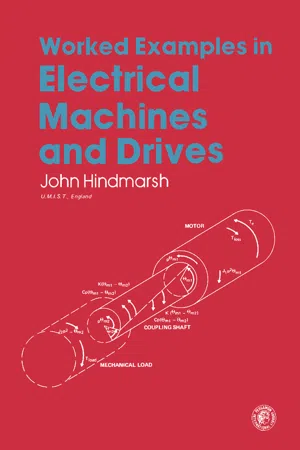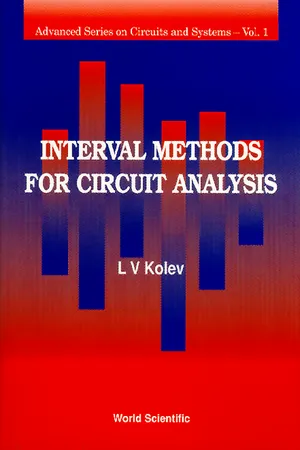Physics
Transient Analysis
Transient analysis in physics refers to the study of a system's behavior during the transition from one steady state to another. It involves examining how the system responds to sudden changes or disturbances. This analysis helps in understanding the dynamic behavior of physical systems and is commonly used in fields such as electrical circuits, mechanical systems, and thermodynamics.
Written by Perlego with AI-assistance
Related key terms
1 of 5
5 Key excerpts on "Transient Analysis"
- eBook - PDF
Worked Examples in Electrical Machines and Drives
Applied Electricity and Electronics
- John Hindmarsh, P. Hammond(Authors)
- 2013(Publication Date)
- Pergamon(Publisher)
CHAPTER 6 TRANSIENT BEHAVIOUR So FAR, nearly all the examples have been concerned with steady-state behaviour. It is important however to introduce the ideas underlying the equally significant behaviour which occurs during the approach to, or the retreat from a particular steady state. The transient state is a very interesting field for mathematical and com-puter experts, but it is still possible to study many practical aspects of machine transients without going much beyond the theory of the first-order differential equation. Thermal, electrical and mechanical transients are all partly covered by such simple equations, though clearly these will have to become more complex as more elements and control circuits are included in the system of which the machine may be only the main power unit. Usually the machine has a much larger time-constant than the control and power-electronic time-constants, so has a dominant effect and will be the area of study in this chapter as a simple introduction to the topic. Even for the machine itself, the mechanical time-constant is usu-ally much greater than the electrical time-constants and so the electrical and mechanical responses can often be studied separately. The meaning of this is that the electrical-system changes take place at virtually constant speed and the mechan-ical changes take place after the electrical system has virtually reached its steady state. This particular problem will be discus-sed in illustrative examples but of course in the space avail-able, the coverage of the transient state can only be limited and selective. 176 - eBook - PDF
- J. David Irwin, R. Mark Nelms(Authors)
- 2022(Publication Date)
- Wiley(Publisher)
C H A P T E R 6 6 6.1 ❯ Introduction In this chapter we perform what is normally referred to as a Transient Analysis. We begin our analysis with first-order circuits—that is, those that contain only a single storage element. When only a single storage element is present in the network, the network can be described by a first-order differential equation. Our analysis involves an examination and description of the behavior of a circuit as a func- tion of time after a sudden change in the network occurs due to switches opening or closing. Because of the presence of one or more storage elements, the circuit response to a sudden change will go through a transition period prior to settling down to a steady-state value. It is this transition period that we will examine carefully in our Transient Analysis. One of the important parameters that we will examine in our Transient Analysis is the circuit’s time constant. This is a very important network parameter because it tells us how fast the circuit will respond to changes. We can contrast two very different systems to ob- tain a feel for the parameter. For example, consider the model for a room air-conditioning system and the model for a single-transistor stage of amplification in a computer chip. If we change the setting for the air conditioner from 30°C to 20°C, the unit will come on and the room will begin to cool. However, the temperature measured by a thermometer in the room will fall very slowly and, thus, the time required to reach the desired temperature is long. However, if we send a trigger signal to a transistor to change state, the action may take only a few nanoseconds. These two systems will have vastly different time constants. - eBook - PDF
- L Kolev(Author)
- 1993(Publication Date)
- World Scientific(Publisher)
On the other hand, there are numerous situations where the prime concern is whether the circuit (system) studied will meet some specified dynamic performance requirements for all possible variations in a set of parameters. This dynamic extension of tolerance analysis is usually referred to (especially in control engineering literature) as the performance robustness problem (e.g. [54]). A well-known example of performance robustness is the problem where a state variable x k {f) should not exceed some prescribed threshold value x ^ under all admissible parameter variations (typically, x^^ is the tolerated overshoot of the dynamic system considered). A similar problem arises in the setting of relay protections: the relay should not react to all responses of the circuit protected due to normal parameter variations but should operate under abnormal Transient Analysis of linear circuits 249 conditions. Once again determination of the maximum value of the corresponding circuit response under all possible parameter changes is of paramount importance. Transient tolerance analysis of linear electric circuits gives rise to a greater variety of problems as compared with the steady-state tolerance analysis studied in Chapters 2 and 3. In section 5.1 of this chapter an attempt is made to introduce a classification scheme for the dynamic tolerance analysis problems and the methods for their solution. Three basic approaches to formulating transient tolerance problems are presented: explicit form formulation, frequency-domain formulation and time-domain formulation. The explicit formulation (subsection 5.1.1) is a rather general form of stating dynamic tolerance problems since it allows for arbitrary input parameters and nonzero initial conditions depending on the input parameters. Using this approach the dynamic tolerance problem is, in fact, reduced to an explicit static tolerance problem and can be solved approximately or exactly by means of the methods developed in Chapter 2. - eBook - PDF
- Chengshan Wang, Jianzhong Wu, Janaka Ekanayake, Nick Jenkins, Chengshan Wang, Jianzhong Wu, Janaka Ekanayake, Nick Jenkins(Authors)
- 2017(Publication Date)
- CRC Press(Publisher)
211 C H A P T E R 7 Transient Analysis 7.1 Introduction With the ability to connect renewable energy generation and distributed energy storage and the advent of novel power electronic equipment, dis- tribution systems are changing from passive networks to active networks. It is important to study the transient behaviour of such active distribution networks as stability and reliability may be compromised due to the varia- tion of renewable generation and switching of power electronic equip- ment. This chapter addresses the Transient Analysis of distribution systems through electromagnetic transient simulations. 7.2 First Example of Electromagnetic Transient Simulation In order to introduce the problem formulation and basic concepts of the electromagnetic transient simulation, the boost circuit shown in Figure 7.1 is used as an example. The inductor current i L and the capacitor voltage v C are selected as the state variable, i.e. x = [i L , v C ] T . Assuming ideal switch characteristics 212 Smart Electricity Distribution Networks of the two power electronic devices S 1 and S 2 , the differential equation describing the boost circuit can be established: p v x Ax B = + s (7.1) where p is the differential operator A and B are the state matrix and input matrix respectively, whose values depend on the status of S 1 and S 2 When S 1 is on and S 2 is off, the boost circuit works in mode 1. Since S 2 is off, the left-hand side and the right-hand side of the circuit can be consid- ered separately. Then the following equations can be written: L di dt v L = s (7.2) C dv dt v R C C − = 0 (7.3) These equations can be written in matrix form as p i v RC i v L v L C L C - = + 0 0 0 1 1 0 s (7.4) Comparing this equation with Equation 7.1, we have A B = - = 0 0 0 1 1 0 RC L , (7.5) When S 1 is off and S 2 is on, the boost circuit works in mode 2. - J. David Irwin, David V. Kerns, Jr.(Authors)
- 2022(Publication Date)
- Wiley(Publisher)
However, there is another method we can apply to obtain a solution to a transient problem that involves only circuit analysis. In an effort to provide as much explanation of the issues involved in performing a Transient Analysis as possi- ble, we will solve the transient problems using both techniques in the hope that a comparison of the two approaches will provide additional insight. The circuit analysis technique involves the determination of several quantities, the use of which provides the necessary data for calculating K 1 , K 2, and τ. First-Order Transient Circuits 103 Calculate the initial conditions In steady state prior to switch action, replace the capacitor with an open circuit or the inductor with a short circuit. Calculate this initial voltage across the capacitor or the initial current in the inductor, i.e. v c (0−) or i L (0−). Then, with the switch in its new position, and a knowledge that these initial values cannot change instantaneously, replace the capacitor with a voltage source v c (0−) or the inductor with a current source i L (0−) and calculate the initial value, x(0), where x(0) is the initial value of the desired quantity, i.e. v 0 (t) or i 0 (t). Calculate the final condition With the switch in its final position and the capacitor replaced with an open circuit or the inductor replaced with a short circuit, determine the final value, x(∞), where x(∞) is the final value of the desired quantity, i.e. v 0 (t) or i 0 (t). Calculate the network’s time constant The time constant, which is common to all voltages and currents in the circuit, is obtained by calculating the Thevenin equivalent resistance, R TH , at the terminals of the storage element with all sources made zero, i.e. voltage sources replaced the short circuits and current sources replaced with open circuits. Then, the time constant τ = R TH C for capacitive circuits and τ = L∕R TH for inductive circuits.
Index pages curate the most relevant extracts from our library of academic textbooks. They’ve been created using an in-house natural language model (NLM), each adding context and meaning to key research topics.




